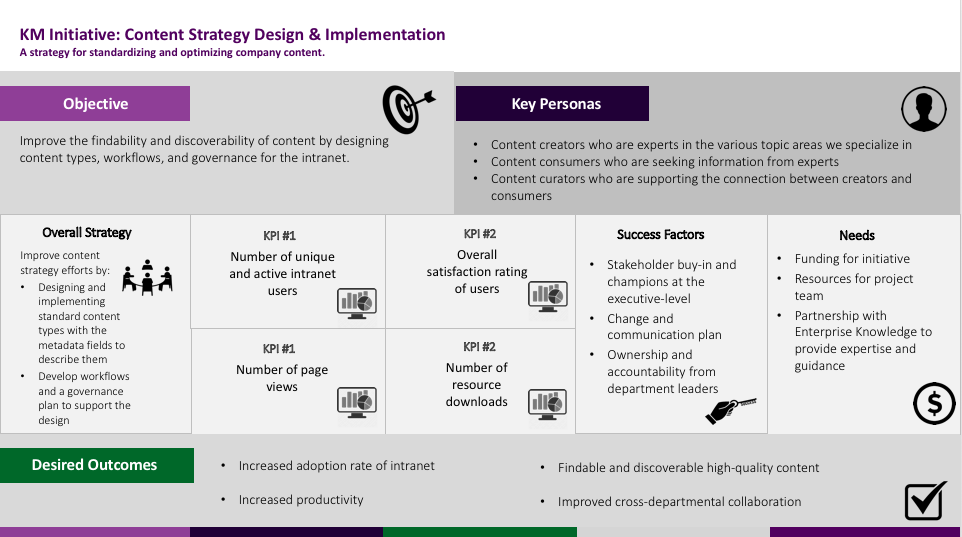As knowledge management professionals, it’s clear to you and me why we should invest in knowledge management initiatives. However, not everyone shares this understanding, especially at the executive level, so what can you do to gain buy-in from senior leaders along with the resources and support you need to be successful?
We’re enthusiastic about our KM initiatives because we know that they can improve the way people collaborate, innovate, and produce meaningful results at work. Executives often have the same objectives, but they may not see the connection between their priorities and what we’re calling “knowledge management.” It’s up to you to help them make this connection. Here are the top three ways to gain executive buy-in and foster a shared vision for your knowledge management initiatives.
1. Align Priorities
At EK, we approach knowledge management from five workstreams: People, Process, Content, Culture, and Technology. This holistic approach means that knowledge management isn’t just about fixing the intranet that no one uses because they can never find anything they’re looking for. Your proposed KM solution may certainly include intranet upgrades but typically consists of much more. For example, a KM initiative may also include the implementation of new knowledge sharing practices like bi-weekly presentations from experts or a KM leadership structure to ensure that your KM initiatives gain momentum over time.
Developing solutions that incorporate these five workstreams leads to longer lasting results. Similar to our physical health, if you treat an ailment myopically with medication, you are likely to have unforeseen side effects; however, if you take an approach that addresses your stress level, diet, and exercise, you are likely to see overall improvements in not only your problem area but in all areas of your mental and physical well-being.
It’s always important to be aware of what your key stakeholders care about and to address those priorities when communicating your plan. Your executives may care about having the brightest people, the best culture, the most cutting-edge technology, seamless collaboration between individuals and teams, and/or quality content that provides useful and engaging information to people inside and outside of the organization. Being able to speak to how a well-designed taxonomy, ontology, content strategy, community of practice, and/or governance structure can achieve those things will encourage them to see that what you’re proposing is not so different from what they are trying to achieve themselves.
2. Create Value
It’s easy to talk abstractly about how the future of KM will change the way we work. Artificial intelligence, virtual reality, and robotics are all fascinating concepts to explore, but you have to walk before you run. Starting with the basic building blocks such as making information more findable and discoverable via a simplified and intuitive taxonomy and content structure creates a foundation that will allow you to invest in more sophisticated features like personalization and recommendation engines in the long run.
It’s important to make sure that your KM initiatives are focused on creating value for the people in your organization who need improved processes and reliable technology. Be able to articulate this value to executives in the context in which they operate: return on investment. If they invest in your KM initiatives, what will the organization gain and by when?
When presenting your KM initiative to executives and other stakeholders, try using a strategy canvas like the one below:

3. Show Results
Once you’ve communicated the business value that your KM initiatives will have, be able to back it up with results. We recommend an agile approach to our KM initiatives because you’re able to show incremental results within months of undergoing your initiatives, rather than years later. These results should be a balance between quantitative metrics such as the time it takes for people to find what they’re looking for as well as qualitative evidence such as anecdotes from employees regarding the significantly improved experience searching for internal information. Rather than implementing an entire program right away, start with a pilot so that you can create a success story for others to see and want to emulate.
Successful KM initiatives are easy to spot because they create palpable change in the way that people work and interact with one another. You’ll see less frustration because people are finding what they need more quickly. Team members will operate more collaboratively rather than in silos because they can easily connect with experts within the organization and are encouraged to so. You’ll sense a lot of energy around learning and sharing information that leads to innovation, growth, and overall job satisfaction.
Conclusion
Effectively implementing your knowledge management initiatives requires you to build partnerships with people in the organization who will have to invest in it, be involved with it, and are most impacted by it. The more effectively you’re able to communicate and demonstrate the positive effects your initiatives can have on the overall health and future of the organization, the more likely executives are to champion your efforts and the less resistance you will encounter from other stakeholders in actualizing your vision. Are you having trouble getting your executives to prioritize knowledge management? EK can help. Contact us.
